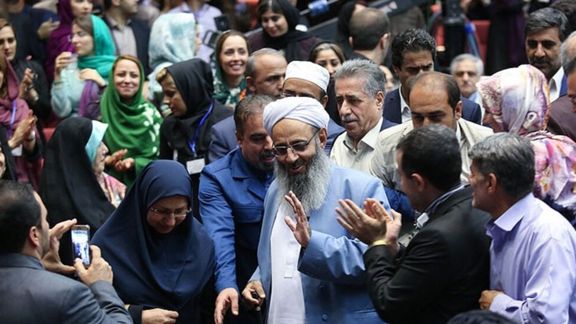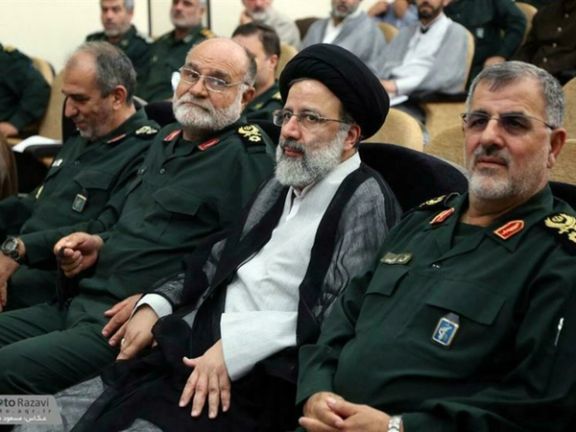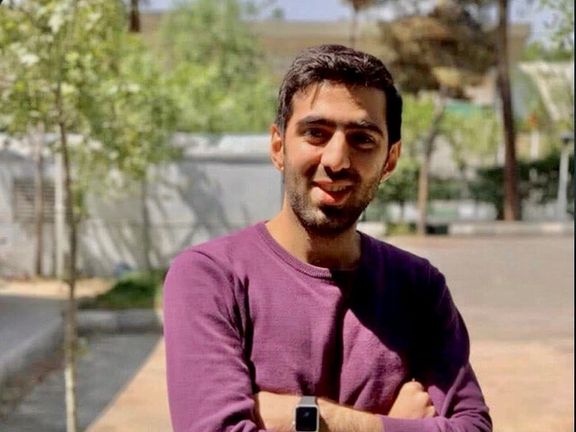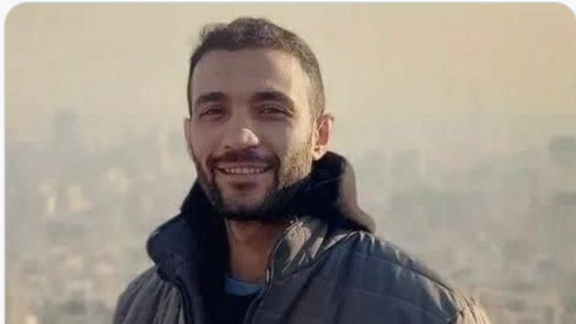Iranians Abroad Hold Demos To Support Protest Movement

Iranians living abroad in solidarity with protesters in Iran once again held antigovernment demonstrations in major world cities.

Iranians living abroad in solidarity with protesters in Iran once again held antigovernment demonstrations in major world cities.
On Saturday, the diaspora in the United States, Canada, Italy, Germany, France, UK, Australia, and several other countries staged rallies against the Islamic Republic.
In Los Angeles, Iranian expatriates rallied at Beverly Hills City Hall while famous artists and personalities such as Dariush Eqbali, Nazanin Bonyadi, Shohreh Aghdashlo and several political activists gave speeches. Similar rallies were staged in New York and Washington DC.
In the Canadian cities of Vancouver and Toronto thousands expressed solidarity with the uprising of Iranians and called for the release of rapper Toomaj Salehi and other political prisoners.
Toomaj Salehi is an Iranian hip hop artist mostly known for his protest songs about Iran's social issues and injustice by the government. Salehi was arrested on October 30th as part of the crackdown on opponents.
In Sydney, Australia, Iranians gathered in Hyde Park demanding an end to the government of the Islamic Republic. Famous Iranian singer Googoosh joined the crowd saying “Today no Iranian is afraid of this regime and will not forget the massacre of brothers and sisters.”
Similar protests were also held in Vienna, Aukland, Perth, Cologne, Hamburg, Stockholm, Gothenburg, London, Copenhagen, Rome, Bern and Paris.
Demonstrations in support of the protest movement of Iran have been held in more than 150 cities around the world up to now.

Some of Iran's relatively moderate political figures seem to be advising the government to find ways to end political deadlock and the dangerous popular uprising.
Nationwide protests have continued for seven weeks and have escalated in recent days as security forces have killed more people and the opposition in the streets has become more determined to overthrow the Islamic Republic’s clerical-military regime.
Former Majles speaker, now a senior adviser to Supreme Leader Ali Khamenei has said that "the government in Tehran badly needs to listen to the other side." Larijani advised the government to consider the fact that "Perhaps the other side is also partly right."
Nonetheless, while the statement signals a sign of rationality, Larijani's next comment shows that like Khamenei he also believes that "enemies" are behind the uprising: "The enemy has targeted Iran as a whole," he said.
Larijani charged, "In a neighboring country, the Americans are openly telling Iran's counter-revolutionaries to be active and exert pressure on Tehran." However, he did not name that country. It is also possible that Larijani is repeating Khamenei’s conspiracy theories as a shield for himself, not to be labelled disloyal by the Supreme Leader’s hardliner supporters.

Referring implicitly to some rude slogans chanted by Iranian protesters against Khamenei, Larijani said: Some of the things we have done in the area of politics has left an impact on our social behavior. He was probably referring to badmouthing, vile accusations, arrogance and unilateralism that have become part of the usual practice among Iran's conservatives.
In another development, former Vice President Massoumeh Ebtekar, also known as Niloofar, one of the "students" that occupied the US embassy in Tehran in 1979 and held 54 US diplomats hostage for 444 days and is known to former US hostages in Iran as Sister Mary, offered her ways out of the current deadlock in a tweet on November 3: "The best way to end this cycle of violence is to stop arresting protesters, listening to their demands, acknowledging that there are problems in the society, restoring justice, respecting Iranian men and women's freedom, making the government accountable, holding effective dialogues with the people, furthering all-encompassing reforms, restoring the people's trust in the government and seeking their political participation in determining their own fate."

That is a pretty tall order that Iran’s reformists have pursued for a quarter of a century, only to see more repression and bad governance.
Ebtekar who seems to have been moved by the violence Iranians witnessed during the protests on November 2, particularly in Karaj near Tehran where at least two security officers were reportedly killed and many others wounded, advised the government to take measures sooner rather than later, because "It will be too late. Seize the opportunity while it lasts," she wrote.
On the contrary, referring to the same violent events, ultraconservative lawmaker Ahmad Naderi wrote in a November 3 tweet: "What happened in Karaj was not a protest. It was a security crisis. The level of confrontation by the security forces should be proportional to the protests, riots, mutiny, and terror. There is no room for appeasement."
Hossein Shariatmadari, the editor of Kayhan daily, which operates under the supervision of Ali Khamenei, Friday also called for harsher crackdown on dissent.
Reformist analyst Mohammad Reza Tajik has opined on Saturday that "The uprising by the Iranian people marks the violent return of a suppressed right to protest, as if we are facing a revolt for restoring the activism right that was in chains for a long time."

A leading Sunni cleric's popularity has been on the rise in Iran even among the Shiite majority since the start of nationwide protests in mid-September.
The rise in Molavi Abdolhamid's popularity is largely because of his brave comments that challenge the absolute authority of Supreme Leader Ali Khamenei.
In his Friday prayers sermons November 4, Molavi Abdolhamid, officially known as Molavi Shaikh Abdolhamdid Esmailzehi, once again called for a referendum in Iran to decide the form of government and political structure. He has done that before. But this time, he wants "an internationally monitored referendum," a characterization that revealed his distrust of the government and rejection of the Shiite clerical rule based on the absolute power of an unelected Supreme Leader.
Although Abdolhamid has been always vocal in upholding the rights of Sunni Iranians, his tone and rhetoric grew increasingly defiant after two rounds of IRGC attacks on Friday prayer crowds in his hometown of Zahedan since September 30. The attacks left more than 100 dead and many more wounded.
Addressing the government, he said on Friday, "A majority of Iranians are unhappy. If you don't agree, hold a referendum with the presence of international observers and accept the result.” He added: “By killing, beating, and arresting, you cannot push back a nation that has been protesting in the streets for 50 days now.”
Last week, a video of him after the second attack went viral on social media. In an extremely emotional and impressive sermon, he said with his chesty voice on 28 October, "The Sunnis have been suffering from discrimination since the start of the Islamic revolution in 1979." He warned the government that "Unilateral decisions are a weakness in the country’s administration."

Fars news agency affiliated with the Revolutionary Guard accused the Sunni leader of encouraging people to revolt on November 5.
Molavi Abdolhamid who had previously supported Reformist President Mohammad Khatami (1997-2005) and moderate conservative Hassan Rouhani (2013-2021), encouraged Iran's Sunni population to support ultraconservative Ebrahim Raisi in the 2021 presidential election. Later he complained that Raisi had refused to fulfil his promises to the country's Sunni community while millions had voted for him. Following the attacks on preachers in Zahedan, some criticized Abdolhamid for having supported Raisi.
However, Abdolhamid was brave enough to hold Khamenei accountable for the attack. Subsequently, some Iranian media began to speculate about the possibility of Molavi Abdolhaid playing a major part in bringing about political change. Abdolhamid, 75, is generally known as one of the most influential political and religious leaders in Iran as nearly 15 million Sunnis listen to him. Their participation in the 2021 election is an indication of his tremendous influence.
In the early history of the Islamic Republic, Molavi Abdolhamid and other Sunni clerics opposed one of the articles of the Constitutional that allowed only Shiites to become president. At the start of the reform movement in 1997, Abdolhamid played a key part as a charismatic leader who rallied the Sunnis behind reformist politician Mohammad Khatami. The history of the Islamic Republic reveals that any candidate who had Abdolhamid's support won the election in Sistan and Baluchistan and Kurdistan Provinces.
Nonetheless, an Interior ministry official characterized Abdolhamid's October 28 sermons as provocative and charged that his words encouraged thousands of Baluch to take to the streets against the government. Thanks to his influence several senior security officers were replaced from their posts after the second attack on Zahedan.
Abdolhamid is respected by Iran's women's movement although women do not agree with his ideas in support of polygamy. Regardless, according to Rouydad24 website in Tehran, many in Baluchistan reportedly refer to Abdolhamid as Amir Al-Momenin [the leader of the pious], a rank that is indicative of his possibly greater role in the future of the region.

The anonymous group calling itself Tehran Youths has once again issued a call for protests in different neighborhoods of the capital and other cities.
Stressing that they will remain in the streets “until the overthrow of the Islamic Republic,” the group asked people to surge to streets Sunday afternoon in memory of Nima Nouri, a teenager from Karaj, who was killed by the direct fire of regime forces and the innocent people who were killed by “Khamenei’s shameless executioners" in the southeastern city of Khash November 4.
The mobility of protesters and their distribution in various neighborhoods, however, has now turned into a big problem for the security forces who are seen in some videos aimlessly running around to confront protesters and exhausting themselves even more after long hours of deployment.
Meanwhile, in the seventh week of the uprising against the Islamic Republic, protesters in Sanandaj in the northwest turned a funeral procession into a protest scene on Saturday.
The merchants and businessmen in Kordestan province closed their shops Saturday in solidarity with those killed Friday in Sistan and Baluchistan in the southeast.
University students, who have turned protests into a routine during weekdays, also held gatherings, sit-ins chanting antigovernment slogans across the country.
In the meantime, the death toll from the Islamic Republic's crackdown on Iran's 2022 protests has increased to 304, including 41 children and 24 women.
The Oslo-based Human Rights Organization said Saturday that the number of yet-to-be-verified reports of casualties is much more than this.

Iran’s President Ebrahim Raisi says “the plots” the United States had previously developed and used against Syria and Libya have failed in Iran.
The hardliner president said the US and other “enemies” were trying to implement the model they already used in Libya and Syria to make Iran “insecure” but their “conspiracy proved futile” in the country.
Top officials of the Islamic Republic repeating past practice have been blaming the United States and other “enemies” for ongoing protests.
Addressing a group of university students, Raisi added Saturday “the riots and those who create insecurity must be dealt with,” however, despite ongoing protests he claimed that cities in Iran are calm at present.
Since the beginning of recent protests in Iran, which was ignited by the death of Mahsa Amini in police custody, security forces have violently repressed the demonstrators in killing nearly 300 people, including dozens of children.
The severe suppression of protests, also in schools and universities, has sparked worldwide reactions with many governments, including the US, expressing solidarity with the Iranian people.
Raisi’s claim about “enemy plots” to turn Iran into Syria is made in a situation that Syrian Bashar al-Assad’s crackdown on protesters became possible only with the military assistance and troops from Iran and Russia.

Iranian authorities try to present protesters killed by security forces as their own supporters who fell victim to the opposition or “impersonating policemen.”
“The history of mankind is full of all sorts of atrocities but stealing corpses is something the Islamic Republic has invented,” a tweet posted on November 1 said.
Some families have spoken up about the authorities’ pressures on them to deny their loved ones were killed by security forces, as others have been suffering in silence.
The family of Mahsa (Jina) Amini, the 22-year-old whose death in police custody sparked the current wave of protests nearly two months ago have publicly spoken of the pressures and threatsto force them to confirm the government version of events that led to her tragic death.
The family of 16-year-old Nika Shakarami was next. Although her own brother and sister were arrested and forced into so-called televised “confessions”, Nika’s mother refused to corroborate the authorities’ account of her daughter’s death.
The troubles of Mahsa and Nika’s families did not stop there.Knowing that the 40th-day memorials of these young people were going to turn into anti-government protests, authorities also tried to force the families to forsake public memorials and mourn inside the confines of their own homes.
Mahsa and Nika’s families resisted the pressures again and huge crowds that attended Mahsa and Nika’s memorials chanted anti-government slogans. In both cases, security forces attacked the participants and shot at them, wounding dozens of people.

Authorities have persistently used similar pressure and threats against the families of others protest victrims.
On several occasions authorities have tried to force families to deny their loved ones’ affiliation with the protests or even validate the government’s claim that the victims belonged to the Basij militia of the Revolutionary Guards (IRGC). They claimed that these were victims of protesters or dodgy “fake policemen”.
Informed sources have told Iran International that under the threat that the body of his son would not be handed over to the family for burial, the father of Ali Fazeli, 29, was forced to corroborate the claim that he was a Basij member killed by protesters in Amol on October 27.
Accordingly, the local IRGC and its Basij militia sidelined the family and took over the burial service.
“Please forgive me Ali, I’m ashamed Ali,” his father is heard crying in footage from the private ceremony on the seventh night of his death at his family home while his mother was weeping.
But there is clear evidence in his social media that Ali Fazeli was a protester and had nothing to do with the Basij militia.
Authorities and hardliners have made similar claims about 30-year-old Hadi Chaksari, also killed in Amol on the same night. They call him, and Ali Fazeli, “Terror Martyrs”.
“It seems that the authorities didn’t expect such reactions [from the families] … These protests are much more wide-spread socially and geographically, from Baluchestan to Kordestan and Khorasan, both small and large cities,” Washington-based sociologist and commentator Hosein Ghazian told Iran International TV Saturday.
According to Ghazian, the government is not able to silence victims’ families with threats and violence as it did in previous protests for various reasons including the fact that now some of the victims hail from social circles who may have been supportive of the regime in the past such as veterans of the Iran-Iraq War (1980-1988). The regime is employing more oppressive measures, to the extent of interfering with the mourning for victims, because of greater solidarity among social classes and the opposition, he added.